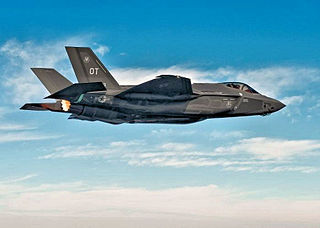| 53d Wing | |
|---|---|
 | |
| Active | 1941–1944; 1955–1960; 1963–present |
| Country | |
| Branch | |
| Role | Operational test and evaluation |
| Size | 2100 |
| Part of | Air Combat Command |
| Garrison/HQ | Eglin Air Force Base |
| Motto(s) | Defense by Offense (1941–1960) |
| Decorations | Air Force Outstanding Unit Award Organizational Excellence Award |
| Commanders | |
| Current commander | Colonel Adrian Spain |
| Notable commanders | Paul V. Hester Ronald Keys |
| Insignia | |
| 53d Wing emblem (Approved 26 May 1964) [2] |  |
The 53d Wing (53 WG) is a wing of the United States Air Force based at Eglin Air Force Base, Florida. The wing reports to the United States Air Force Warfare Center at Nellis Air Force Base, Nevada, which reports to Headquarters Air Combat Command.

The United States Air Force (USAF) is the aerial and space warfare service branch of the United States Armed Forces. It is one of the five branches of the United States Armed Forces, and one of the seven American uniformed services. Initially formed as a part of the United States Army on 1 August 1907, the USAF was established as a separate branch of the U.S. Armed Forces on 18 September 1947 with the passing of the National Security Act of 1947. It is the youngest branch of the U.S. Armed Forces, and the fourth in order of precedence. The USAF is the largest and most technologically advanced air force in the world. The Air Force articulates its core missions as air and space superiority, global integrated intelligence, surveillance, and reconnaissance, rapid global mobility, global strike, and command and control.

Eglin Air Force Base (AFB) is a United States Air Force base in western Florida, located about three miles (5 km) southwest of Valparaiso in Okaloosa County.
In military aviation, a wing is a unit of command. In most military aviation services, a wing is a relatively large formation of planes. In Commonwealth countries a wing usually comprises three squadrons, with several wings forming a group. Each squadron will contain around 20 planes.
Contents
- Units
- History
- World War II
- Cold War Air Defense
- Test and Evaluation
- Lineage
- Assignments
- Stations
- Components
- Aircraft flown
- Awards and campaigns
- See also
- References
- Notes
- Bibliography
- External links
The 53d Wing serves as the focal point for the combat air forces in electronic warfare, armament and avionics, chemical defense, reconnaissance, and aircrew training devices. The wing is also responsible for Operational Testing and Evaluation (OT&E) of new equipment and systems proposed for use by these air forces. Current wing initiatives include advanced self-protection systems for combat aircraft, aircrew life support systems, aerial reconnaissance improvements, new armament and weapons delivery systems, and improved maintenance equipment and logistics support. The 53d Wing, which consists of four groups, numbers almost 2,000 military and civilians at 17 locations throughout the United States.
Electronic warfare (EW) is any action involving the use of the electromagnetic spectrum or directed energy to control the spectrum, attack an enemy, or impede enemy assaults. The purpose of electronic warfare is to deny the opponent the advantage of, and ensure friendly unimpeded access to, the EM spectrum. EW can be applied from air, sea, land, and/or space by manned and unmanned systems, and can target humans, communication, radar, or other assets.

Avionics are the electronic systems used on aircraft, artificial satellites, and spacecraft. Avionic systems include communications, navigation, the display and management of multiple systems, and the hundreds of systems that are fitted to aircraft to perform individual functions. These can be as simple as a searchlight for a police helicopter or as complicated as the tactical system for an airborne early warning platform. The term avionics is a portmanteau of the words aviation and electronics.

Chemical warfare (CW) involves using the toxic properties of chemical substances as weapons. This type of warfare is distinct from nuclear warfare and biological warfare, which together make up NBC, the military acronym for nuclear, biological, and chemical, all of which are considered "weapons of mass destruction" (WMDs). None of these fall under the term conventional weapons which are primarily effective due to their destructive potential. In theory, with proper protective equipment, training, and decontamination measures, the primary effects of chemical weapons can be overcome. In practice, they continue to cause much suffering, as most victims are defenceless civilians. Many nations possess vast stockpiles of weaponized agents in preparation for wartime use. The threat and the perceived threat have become strategic tools in planning both measures and counter-measures.


































